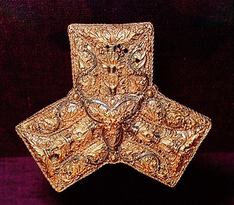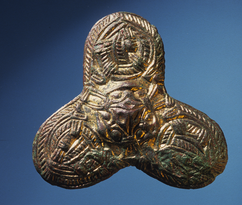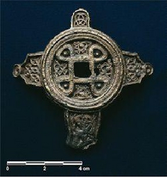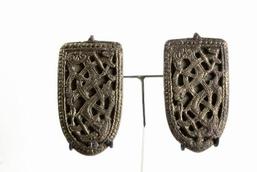Unfortunately, "anything goes" is really nothing more than a myth for most people, times and places.
To break this down, one needs to look at both the culture and evidence from the perspective of the people of the past, and not through our modern filter. Clothing, in period, was often an identifier of one's nationality, social status and, sometimes, religion. Costume was an significant reflection of social identity. If anything, I feel this was more important in mixed cultures (precisely the place where many would impose the "anything goes" theory) than in some other areas.
In Eva Andersson's work on the textiles at Birka ( she references what Inga Hagg and the Souvenir Hypothesis. Andersson states:
Hagg objects to these interpretations, arguing that 'The regularity found in this costume, both chronologically and as regards material, ornamental features, garment combinations, etc. shows that we are dealing with a real costume tradition and not with phenomena of the chance kind that has hitherto been claimed. The "souvenir hypothesis" is also based on a way of reasoning that is actually erroneous. In the history of costume it is normally the case that dress mainly expresses two things in a highly traditional and deliberate way. One is the ethnic affiliation of the wearer. This is sufficiently attested in a great many works about both prehistoric dress and modern folk dress. For that reason alone we are not entitled to assume that the Vikings of Birka, while in foreign countries, abandoned their own costume in favour of something exotic .... There is equally little justification for the assumption that foreign merchants in Birka would have adopted Scandinavian dress' (Hagg 1983, 209£). The costumes in the Birka graves have several distinctive features and therefore cannot be said primarily to be a reflection of the wearer's ethnic origin. Hagg argues that Birka costume instead expressed the status of the wearer (Hagg 1983, 210ff.) and believes that 'in such circumstances it is necessary to investigate whether the Oriental elements of Birka costume 'which cannot easily be interpreted as ethnically conditioned and which can no longer be regarded as souvenirs of travels - may instead designate rank' (Hagg 1983,211).
Viking adornment falls under the heading of anti-fashion. It is the product of a traditional society. Like all traditional
societies, Viking anti-fashion adornment promotes group identity and affiliation as well as cultural distinction. It
conveys a sense of social stability to its members, as well as the values and beliefs of the community. It allows its
members to identify themselves with each other and express to the world where they belong.
We need to look more closely at what evidence we do have. Yes, there was trade! Yes, there were incredible foreign items found in the context of Viking graves! But it is very important to consider the item itself, the source of the item, whether or not it was repurposed, and, most importantly, look at it in context of the entire find.
- One common example is Frankish belt mounts. These items were sometimes repurposed as brooches, worn by women. This eventually lead to local production of trefoil brooches, which became a status item during the Viking Age. (Helle, 123)
- Another common example would be items imported from the British Isles. Many of these items were once from horse harnesses or from items such as elaborate religious books. As with the belt mounts, the were frequently also converted to brooches or belt fittings.
- Sometimes belt-strap ends were converted into brooches. This to eventually lead to new style of brooches.
 Celtic brooch found in a Viking grave in Norway. (Glørstad, 32)
Celtic brooch found in a Viking grave in Norway. (Glørstad, 32) Of course, items were sometimes used without revision. There are ample examples of Celtic penannular brooches in Viking graves. Likewise, Slavic pendants show up in graves from Birka that also contain the traditional oval brooches, items that signifies Norse dress.
Most important consideration
Looking at the overall context of items in the grave is, perhaps, the most important factor when planning to use foreign goods as part of your kit. Key points to consider:
- Social Status: Most trade goods were found in upper class graves. The rest of the kit should be commensurate with this social status. Is the cloth for the clothing an appropriate weight, weave and color? Do other types of decoration reflect this status as well? Even if you choose to portray those few graves mentioned by Hagg in her work at Birka, it is good to note that those individuals were of the highest ranks, might have adopted foreign dress, to some extent, as a manner of showing their status. Even then, it is bringing in something such as Byzantine dress and it is still not a hodge-podge of collected bits from numerous cultures.
- Gender: Is the item appropriate for the gender of your persona? Can the item you desire using be repurposed as something that makes more sense in context of gender?
- Moderation: I do not know of any one grave that has a dozen different foreign items covering a half dozen different locations (or worse, a half dozen centuries). A strip of imported silk and an Irish brooch, for example, would be sufficient to show high status and foreign connections, without falling prey to the fallacy of "anything goes". Choose these accent pieces carefully and apply them appropriately.
This post is meant only to be a quick summary on my thoughts on dress and foreign goods in Viking society. It is by no means comprehensive. I highly recommend looking at some of the references below, as well as further researching how dress historically reflected the social identity in any culture, for those who want to accurately portray a persona who would have traveled, or had access to, foreign goods.
Andersson Strand, Eva. Tools for Textile Production – from Birka and Hedeby. Stockholm, 2003. (Birka studies; No. 8).
Glørstad, Zanette Tsigaridas, ‘Sign of the Times? The Transfer and Transformation of Penannular Brooches in Viking Age Norway’, 2012, 37–41
Hayeur Smith, Michele. Draupnir's Sweat and Mardoll's Tears: An Archaeology of Jewellery, Gender and Identity in Viking Age Iceland, 2004.
Helle, Knut, The Cambridge History of Scandinavia, Issue 1, (Cambridge University Press). 2003.
Heen-pettersen, Aina Margrethe, ‘Insular Artefacts from Viking - Age Burials from Mid - Norway . A Review of Contact between Trøndelag and Britain and Ireland’, 2014
Skre, Dagfinn, ‘From Dorestad to Kaupang: Frankish Traders and Settlers in a 9th Century Scandinavian Town’, Dorestad in an International Framework, 1991, 131–35
Sorheim, Helge, ‘Three Prominent Norwegian Ladies with British Connections’, Acta Archaeologica, 82 (2011)




 RSS Feed
RSS Feed